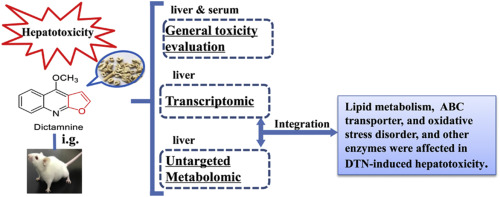当前位置:
X-MOL 学术
›
J. Proteomics
›
论文详情
Our official English website, www.x-mol.net, welcomes your
feedback! (Note: you will need to create a separate account there.)
Integration of transcriptomics and metabolomics profiling reveals the metabolic pathways affected in dictamnine-induced hepatotoxicity in mice.
Journal of Proteomics ( IF 2.8 ) Pub Date : 2019-12-05 , DOI: 10.1016/j.jprot.2019.103603 Zhuo-Qing Li 1 , Ling-Li Wang 1 , Jing Zhou 1 , Xian Zheng 1 , Yan Jiang 2 , Ping Li 1 , Hui-Jun Li 1
Journal of Proteomics ( IF 2.8 ) Pub Date : 2019-12-05 , DOI: 10.1016/j.jprot.2019.103603 Zhuo-Qing Li 1 , Ling-Li Wang 1 , Jing Zhou 1 , Xian Zheng 1 , Yan Jiang 2 , Ping Li 1 , Hui-Jun Li 1
Affiliation

|
Dictamnine (DTN), a major furoquinoline alkoloid from Dictamni Cortex, was reported to induce hepatotoxicity. However, the underlying mechanism is unclear. In the present study, integrated transcriptomic and metabolomics analysis of mouse liver was performed in combination with serum biochemical and histopathological evaluation to investigate the potential mechanism. The results suggested that 640 mg/kg DTN significantly increased serum alanine transaminase and aspartate transaminase levels and induced serious cellular degeneration, with no changes occurring with 4 mg/kg DTN. Integrated analysis suggested that the metabolism of xenobiotics by cytochrome P450, drug metabolism-other enzymes, bile secretion and glutathione metabolism were the major metabolic pathways involved in DTN-induced hepatotoxicity. Notably, 640 mg/kg DTN exposure increased hepatic GSH, GSH peroxidase, superoxide dismutase and malondialdehyde, and decreased ROS, together with altered expression of Idh2 and Nedd9. Representative genes, including Mup12, Lipc, NTCP, MRP3, MRP4, CYP2E1, CYP2D9 and UGT1A9, in altered pathways were verified through PCR and Western blot. Collectively, the combined strategy of transcriptomics and metabolomics profiling could facilitate a better understanding for the discovery of metabolic pathways and that oxidative damage, ABC transporters and lipid metabolism might be the mechanisms linked to DTN-induced hepatotoxicity in mice. SIGNIFICANCE: Dictamnine (DTN) was reported to induce hepatotoxicity. Nevertheless, the underlying mechanism is unknown. This study is the first to utilize integrated transcriptomics and metabolomics in combination with general toxicity evaluation to characterize the potential molecular mechanism in DTN-induced hepatotoxicity in mice. We found that acute exposure to higher dose of DTN induced hepatocellular liver injury with more changes in biochemical parameters, genes and metabolites. Gene expression and metabolite profiles were more sensitive than general toxicity studies for detecting earlier hepatotoxicity. Integrated analysis suggested that oxidative damage, ABC transporters and lipid metabolism were closely correlated with DTN-induced hepatotoxicity. Overall, our results provide insights into the mechanism responsible for DTN-induced hepatotoxicity.
中文翻译:

转录组学和代谢组学分析的整合揭示了在小鼠烟碱诱导的肝毒性中影响的代谢途径。
据报道,Dictamnine(DTN)是Dictamni Cortex的主要呋喃喹啉类生物碱,可引起肝毒性。但是,其潜在机制尚不清楚。在本研究中,结合血清生化和组织病理学评估,对小鼠肝脏进行了转录组学和代谢组学综合分析,以探讨其潜在机制。结果表明640 mg / kg DTN可以显着提高血清丙氨酸转氨酶和天冬氨酸转氨酶的水平,并引起严重的细胞变性,而4 mg / kg DTN则无变化。综合分析表明,细胞色素P450异源生物的代谢,药物代谢-其他酶,胆汁分泌和谷胱甘肽代谢是DTN诱导的肝毒性的主要代谢途径。尤其,640 mg / kg的DTN暴露会增加肝脏GSH,GSH过氧化物酶,超氧化物歧化酶和丙二醛的含量,并降低ROS,以及Idh2和Nedd9的表达改变。通过PCR和Western印迹验证了途径改变的代表性基因,包括Mup12,Lipc,NTCP,MRP3,MRP4,CYP2E1,CYP2D9和UGT1A9。总体而言,转录组学和代谢组学分析的组合策略可以促进对代谢途径发现的更好理解,并且氧化损伤,ABC转运蛋白和脂质代谢可能是与DTN诱导的小鼠肝毒性相关的机制。重要性:据报道,地西汀(DTN)可诱导肝毒性。但是,其潜在机制尚不清楚。这项研究是首次利用整合的转录组学和代谢组学与一般毒性评估相结合来表征DTN诱导的小鼠肝毒性的潜在分子机制。我们发现,急性暴露于较高剂量的DTN会导致肝细胞肝损伤,其生化参数,基因和代谢产物发生更多变化。基因表达和代谢物谱比一般毒性研究更灵敏,可以更早地检测出肝毒性。综合分析表明,氧化损伤,ABC转运蛋白和脂质代谢与DTN诱导的肝毒性密切相关。总体而言,我们的结果提供了对DTN诱导的肝毒性的机制的见解。我们发现,急性暴露于较高剂量的DTN会导致肝细胞肝损伤,其生化参数,基因和代谢产物发生更多变化。基因表达和代谢物谱比一般毒性研究更灵敏,可以更早地检测出肝毒性。综合分析表明,氧化损伤,ABC转运蛋白和脂质代谢与DTN诱导的肝毒性密切相关。总体而言,我们的结果提供了对DTN诱导的肝毒性的机制的见解。我们发现,急性暴露于较高剂量的DTN会导致肝细胞肝损伤,其生化参数,基因和代谢产物发生更多变化。基因表达和代谢物谱比一般毒性研究更灵敏,可以更早地检测出肝毒性。综合分析表明,氧化损伤,ABC转运蛋白和脂质代谢与DTN诱导的肝毒性密切相关。总体而言,我们的结果提供了对DTN诱导的肝毒性的机制的见解。ABC转运蛋白和脂质代谢与DTN诱导的肝毒性密切相关。总体而言,我们的结果提供了对DTN诱导的肝毒性的机制的见解。ABC转运蛋白和脂质代谢与DTN诱导的肝毒性密切相关。总体而言,我们的结果提供了对DTN诱导的肝毒性的机制的见解。
更新日期:2019-12-05
中文翻译:

转录组学和代谢组学分析的整合揭示了在小鼠烟碱诱导的肝毒性中影响的代谢途径。
据报道,Dictamnine(DTN)是Dictamni Cortex的主要呋喃喹啉类生物碱,可引起肝毒性。但是,其潜在机制尚不清楚。在本研究中,结合血清生化和组织病理学评估,对小鼠肝脏进行了转录组学和代谢组学综合分析,以探讨其潜在机制。结果表明640 mg / kg DTN可以显着提高血清丙氨酸转氨酶和天冬氨酸转氨酶的水平,并引起严重的细胞变性,而4 mg / kg DTN则无变化。综合分析表明,细胞色素P450异源生物的代谢,药物代谢-其他酶,胆汁分泌和谷胱甘肽代谢是DTN诱导的肝毒性的主要代谢途径。尤其,640 mg / kg的DTN暴露会增加肝脏GSH,GSH过氧化物酶,超氧化物歧化酶和丙二醛的含量,并降低ROS,以及Idh2和Nedd9的表达改变。通过PCR和Western印迹验证了途径改变的代表性基因,包括Mup12,Lipc,NTCP,MRP3,MRP4,CYP2E1,CYP2D9和UGT1A9。总体而言,转录组学和代谢组学分析的组合策略可以促进对代谢途径发现的更好理解,并且氧化损伤,ABC转运蛋白和脂质代谢可能是与DTN诱导的小鼠肝毒性相关的机制。重要性:据报道,地西汀(DTN)可诱导肝毒性。但是,其潜在机制尚不清楚。这项研究是首次利用整合的转录组学和代谢组学与一般毒性评估相结合来表征DTN诱导的小鼠肝毒性的潜在分子机制。我们发现,急性暴露于较高剂量的DTN会导致肝细胞肝损伤,其生化参数,基因和代谢产物发生更多变化。基因表达和代谢物谱比一般毒性研究更灵敏,可以更早地检测出肝毒性。综合分析表明,氧化损伤,ABC转运蛋白和脂质代谢与DTN诱导的肝毒性密切相关。总体而言,我们的结果提供了对DTN诱导的肝毒性的机制的见解。我们发现,急性暴露于较高剂量的DTN会导致肝细胞肝损伤,其生化参数,基因和代谢产物发生更多变化。基因表达和代谢物谱比一般毒性研究更灵敏,可以更早地检测出肝毒性。综合分析表明,氧化损伤,ABC转运蛋白和脂质代谢与DTN诱导的肝毒性密切相关。总体而言,我们的结果提供了对DTN诱导的肝毒性的机制的见解。我们发现,急性暴露于较高剂量的DTN会导致肝细胞肝损伤,其生化参数,基因和代谢产物发生更多变化。基因表达和代谢物谱比一般毒性研究更灵敏,可以更早地检测出肝毒性。综合分析表明,氧化损伤,ABC转运蛋白和脂质代谢与DTN诱导的肝毒性密切相关。总体而言,我们的结果提供了对DTN诱导的肝毒性的机制的见解。ABC转运蛋白和脂质代谢与DTN诱导的肝毒性密切相关。总体而言,我们的结果提供了对DTN诱导的肝毒性的机制的见解。ABC转运蛋白和脂质代谢与DTN诱导的肝毒性密切相关。总体而言,我们的结果提供了对DTN诱导的肝毒性的机制的见解。










































 京公网安备 11010802027423号
京公网安备 11010802027423号